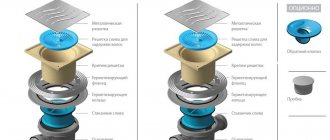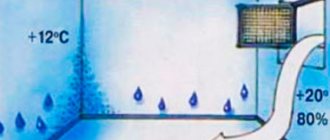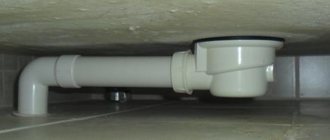Since the bathroom is often used for warm showers, bubble baths or other good-smelling products, it is generally considered to be the cleanest place in the house. An unpleasant sewer smell can ruin this entire idyll. There can be many reasons for this phenomenon, and each individual case needs to be considered in more detail. In addition, it is important to correctly determine the method of combating unpleasant odors.
installation of a shower cabin and connecting it to the sewer system
Smell from shower drain
The presence of an unpleasant odor from the shower drain indicates the absence of a water seal.
That is, about incorrect installation of the drain siphon. You will have to crawl under the cabin and reinstall the siphon. It must be mounted so that the horizon of the water sink is completely filled with water. Otherwise, in addition to the unpleasant odors of the communal sewage system, entire armies of pathogenic bacteria and pathogenic fungi begin to penetrate into the apartment. If you have a siphon under the pan, then you need to take measures to clean and rinse it.
Apparently the fat and dirt accumulated in it are actively decomposing and bacteria are multiplying, as a result of which you feel an unpleasant odor, so you need to use cleaning agents, something like mole or mechanically disassemble and rinse/clean the siphon.
If you do not have such a siphon, and the drain of the shower stall is made directly into the riser, then such a siphon must be installed, otherwise you will continue to smell odors from the sewer.
What to do if it is not possible to install a siphon, then the second option is to use a plug to close the drainage hole when the shower stall is not in use, thus minimizing the entry of odors into the room.
By the way, many people have this problem due to the impossibility (lack of space) of installing a siphon under the shower tray; people connect the drainage directly, and put a valve on the neck instead of a standard grille.
It is very convenient, the principle of operation is like a stopper in a thermos, double pressing, pressed open, pressed closed, just stepped on and the drainage opened, stepped on again after taking a shower and the drainage is tightly closed with the stopper.
Users of shower cabins often encounter this problem: after taking water procedures, the liquid leaves the tray very slowly.
The reasons for this can be completely different: a clogged siphon, a common sewer, or an incorrect installation of the cabin.
All these factors can lead not only to poor drainage, but also to the appearance of an unpleasant odor. In our article we will talk in detail about the reasons for slow drainage, as well as how to remove the blockage and clear the drain in the shower without consequences for the plumbing. After all, the use of aggressive chemicals can damage the siphon and pipes .
Why does water drain poorly?
To find the right method to solve the problem, you must first determine the main reason for the stagnation of water in the pan.
Long corrugation
When connecting a shower stall to a sewer, the siphon is often connected to the main riser using a corrugated pipe. In this case, it is very important to choose the length of the corrugation such that it does not sag .
But some inexperienced plumbers ignore this point and install a pipe that is too long.
To cope with this problem, you need to replace the corrugated pipe with a shorter one. You can also place bars or bricks under it so that it does not sag.
The most optimal solution to the problem of the second siphon is to replace the flexible corrugated pipe with a rigid, smooth one.
Incline
Often, liquid goes down the drain slowly due to the fact that the angle of the drain pipe is not maintained. As a rule, pipes with a diameter of 50 mm are used to lead shower cabins to the sewer.
For them, it is recommended to maintain a slope of 3 cm for each linear meter of pipe length . If your figure is lower, or the pipes are generally laid horizontally, you need to provide a steeper slope. But how to do that?
The problem is that it is not always possible to physically implement the slope. Very often, the shower siphon is located at the level of the socket of the general sewer system. That is, when they are connected, a horizontal section is obtained. In this case, there is only one way out - you need to raise the shower stall so that the siphon is higher and the drain gets the desired slope.
You can do this in two ways:
Blockage
The most common reason why water does not drain from the shower stall is a blockage. Inevitably, debris accumulates in the sewer system, which interferes with the normal operation of the plumbing. We will talk about this in detail below.
To avoid such blockages, you need to regularly flush the drain with hot water. For meter owners, this method will cost a pretty penny. Therefore, it is better for them to use special means, which will be described in detail below. In addition, you need to clean the drain hole from hair and small debris at least once every three days.
Sewer stench is dangerous
If residents who have moved into a new house feel a not-so-pleasant “aroma” in the rooms, perhaps the builders or DIYers made mistakes when installing the sewer system.
Due to violations associated with the laying of pipes - especially non-compliance with the angle of inclination, which is prescribed in the standards, wastewater in the pipes can stagnate, causing a specific odor.
When laying a sewer system, it is important to comply with engineering requirements: all work must be carried out in strict accordance with current regulations
A radical way to get rid of the stench will be a complete replacement of communications with the installation of a new system in strict accordance with technical specifications.
In some cases (when using metal-plastic pipes), the situation can be saved by adjusting tightened pipe connections, replacing gaskets, and installing specially selected sealing collars.
In order to prevent clogging, it is periodically necessary to flush the sewer system, the rules for which will be introduced in our article.
Causes
There are 3 main causes of blockage.
1. Debris and hair. After each shower, your hair, threads from clothes, and pet hair get into the drain, and it gradually becomes clogged.
Even if you carefully monitor the cleanliness of the bathroom, this is inevitable. After some time, the debris clumps together and forms a blockage, which complicates the drainage of water from the pan.
2. Small items. Sometimes it happens that small objects fall into the drain hole: stones from jewelry, pieces of gel polish, or something from the floor. Such things do not pass down the siphon and interfere with the outflow of water.
3. Grease and soap residue. Deposits of grease and soap accumulate on the walls of the sewer. Over time, the layer of dirt grows, debris sticks to it, and water begins to flow worse.
How to fix it at home?
What to do if the shower drain is clogged? Below we present 4 of the most effective methods, which very often help with the formation of a blockage:
plunger
A plunger is one of the simplest devices for cleaning plumbing drains. It is found in almost every home.
To remove a blockage with a plunger, before using it, you need to lubricate its edges with Vaseline - this will help the suction cup better adhere to the plumbing fixtures.
How to use it correctly? If the shower stall is dry, fill it with a little water so that it covers the head of the plunger. Its valve must be positioned so that the edges are completely adjacent to the surface and the drain is closed.
Place the plunger at a slight angle to allow air to escape from the siphon. After all the preparatory stages, you need to make about 20 back-and-forth movements up and down. When you have removed the fixture, run hot water and flush the drain hole - this will help remove any remaining debris.
Disassembling the siphon
If the previous option did not help, you can disassemble the shower siphon. In general, it is recommended to clean it not only when you have a problem with draining water, but also for prevention 4-6 times a year.
Cleaning and disassembly instructions:
Plumbing cable
If the water drainage is still poor, then the blockage has formed deeper and you need to use a plumbing cable. Cleaning the drain hole with its help is quite simple. The cable can be made from improvised materials, but it is better to buy it in a specialized store.
It is advisable not to insert the cable directly into the drain hole. For convenience, it is better to remove the siphon and work with the sewer pipe outlet.
When the cable has gone deep enough, you need to turn it several times and carefully remove it.
Hair or debris may become caught on the end of the fixture, preventing water from flowing down the drain. In case of cleaning with a cable, the drain must be rinsed with hot water after completing the plumbing work.
Can it be cleaned with cleaning agents?
You can also clean the siphon using household chemicals.
You need to be careful in choosing funds. Aggressive components can corrode not only grease, hair and other debris accumulated in the pipe, but also the material that makes up the sewer system. The well-known “Mole” cannot be used for plastic pipes.
First of all, you need to pay attention to the label; it indicates for which pipes the product can be used. Below we present 3 of the most popular compositions that will help remove blockages.
Tire Turbo. As the advertisement says, it removes all known blockages in 5 minutes. In principle, it copes with blockages quite well, but not in 5 minutes. This usually takes at least 1.5 - 2 hours.
When used, chlorine is released in the form of gas, so good ventilation of the room is a prerequisite.
Sanox is a pure waste. Ideal for preventing and removing light blockages. Unfortunately, the composition cannot cope with heavy ones, but it guarantees complete safety for plastic pipes.
Bagi - pothan . The real heavy artillery among anti-clog products. It contains caustic soda, which reacts violently when in contact with water. The product is intended specifically for removing heavy blockages. For prevention and weekly cleaning, it is better to use softer compounds.
Wear gloves and a medical mask to protect yourself from chemicals.
As for the instructions for use, the label of each composition contains its own special algorithm for removing blockages, which you should definitely follow. This will protect your pipes from unwanted damage.
Traditional methods
But what to do if there are no suitable household chemicals at home, and the clog just won’t go away? Not everyone knows that substances that almost every person has at home can cope with simple blockages.
Soda and vinegar . An excellent combination that will allow you to cope with light stains in the shower drain.
If the cause of the blockage is lime deposits, you can try using another method: citric acid .
It is important to ensure that boiling water does not get on the acrylic coating of the shower tray , otherwise it can damage it.
What to do if there is a sewer smell coming from the drain?
It may be that you regularly clean the room, fill the plumbing with chemicals, but this does not help. And the unpleasant smell of sewage from the drain is still present, how can you remove it?
If the technology is violated, an unpleasant odor may come from the pallet. In some cases it can be eliminated.
To fix the problem, you need to find out where it is coming from.
Why does the shower smell like sewer? The most common reason is improper plumbing design. If the siphon is installed according to the rules, then the water will go into the sewer, and a small part will remain in the pipe. This creates a water seal that prevents unpleasant odors from filling the apartment. When there is no water seal, the sewer smell goes directly into the bathroom.
Don't ignore the unpleasant smell of sewerage. Even if it does not affect your mood and general condition in any way, you need to remember that it is harmful to your health. Hydrogen sulfide and ammonia can have a detrimental effect on the respiratory tract.
If everything is in order with the siphon design, then the reason may be a damaged sewer pipe. If the tube has come loose and does not fit tightly to the riser, an unpleasant odor may appear.
In addition, the problem may lie in the fact that the remains of skin and debris that accumulate in the pipe begin to rot. If you are sure that everything is in order with the plumbing, then you need to clean the siphon using the methods that we wrote about above.
Sources of stench - common options
Modern houses are equipped with a sophisticated sewer system designed to remove residual waste products. Its operation is accompanied by specific odors, since wastewater flowing through the pipes emit hydrogen sulfide and other unpleasant-smelling substances.
When the sewerage system is working properly, the “aroma” in the premises (including the bathroom, kitchen, toilet) is almost imperceptible. Its appearance indicates a malfunction in the functioning of technical communications or plumbing fixtures.
The most common causes of stench can be:
- Mistakes made when installing the sewer system. The appearance of odors in the room may be due to improper installation of pipes or loose connections.
- Burst of a sewer pipe in the central or apartment distribution system. A leak can be either obvious or almost invisible: a microcrack or a joint not treated with sealant is often enough for gases and moisture to leak through.
- Inadequate assembly quality of the siphon or its malfunction. This component of plumbing design plays an important role in preventing the entry of foul gases.
- Blocked pipes or drains. Household waste, hair, and food waste that accumulate in siphons or pipes begin to rot, releasing a specific “aroma.”
- A malfunction in the operation of the water seal, as a result of which the “water plug” is destroyed, which prevents the appearance of sewer odors.
- Defects in the functioning of ventilation, which is equipped in apartment and private buildings. The system is designed to remove stench from the sewer system; If she doesn't do a good job, the stench penetrates the apartments.
- Incorrect connection or violation of operating instructions for the washing machine. In some cases, a useful unit becomes a source of a specific odor.
We suggest you familiarize yourself with How to attach curtain rods to the wall
In addition to those listed, there are many other reasons that cause “odors” in the room. Some of them are easily removable, others require the help of specialists, and often extensive, expensive work.
Below we will look in detail at the various sources of stench and tell you what measures need to be taken in specific cases.
Image gallery
Photo from
Odor is the cause of sewerage problems
Lack of ventilation and blockages in pipes
Siphon clogged and water seal leaking
Major damage to pipes and equipment
Video
We have prepared for you an interesting video on how to clear a blockage using a modern plumbing cable and drill.
To ensure that water flows normally into the drain and there is no unpleasant odor, clean the pipe using the method that suits you best. Don’t forget to clean your pipes four to six times a year as a preventative measure. To reduce problems with water drainage, buy a drain mesh. It blocks most of the debris that may end up in the siphon.
There are a number of reasons for an unpleasant odor coming from the opening of the shower stall.
The unpleasant sensation of volatile odors is often caused by gases from the drain that flow back into the shower drain. In addition, the exhaust fan may not be working properly. If the unpleasant sensation of smell is not caused by one of these problems, the presence of odorous substances not coming from the drain may in fact be a separate problem in the bathroom.
Condensation Formation
The reason for the formation of condensation on sewer pipes is the difference in temperatures outside and inside the pipe. Because of this, mold and mildew may appear in places where condensation accumulates, causing an unpleasant odor. In addition, they are also very harmful to health. The fungus appears in rooms with high air humidity, and it is extremely difficult to get rid of it.
This problem can be avoided if you constantly monitor the condition of the pipes. If condensation is detected, the pipeline should be wiped and insulated (for more details: “How to remove condensation from cold water pipes - eliminating causes and consequences”). Thanks to this, in the future there will be no large temperature difference, and therefore the formation of wet marks.
The pipes should be located in such a way that they are easy to reach. If they are located in a place where access is difficult, eliminating the problem will become problematic. The slightest crack in a pipe can lead to the need to dismantle a large part of the room to get to it.
Causes of sewer smell
Over time, plugs gradually form as particles pass through a shower screen and collect along the wall of the pipe. The organic matter in the clog will begin to decompose, releasing volatile substances from the shower drain that will become increasingly pungent. If there is a bad effect on the sense of smell coming from the drain and water takes a long time to pass through the drain, then a clog is a more likely cause. By removing armpit hair there may be a blockage, removing it eliminates this nuisance.
Biofilms can also be the cause of terrible shower odors. Composed of layers of bacteria, bacterial waste and mold, biofilm can grow in almost any aquatic environment that provides adequate nutrients, such as shower drains. When the water has a small amount of sulfate and there are some bacteria within the biofilm, the biofilm will produce hydrogen sulfide. This chemical has a powerful and distinct rotten egg signature.
Flushing bleach down the drain eliminates the bacteria nuisance.
The shower drain is a pipe that is bent. This bend is known to many as a trap, and it must be completely filled with water to prevent sewer gases from entering the house. When the shower is not in use, the trap can dry out and sewer gases can flow through the drain. Running water through the trap can eliminate this sensation.
As water flows down the drain, it displaces air from the pipe. The air in the pipe exits through the plumbing vents rather than down the drain. If the vent cover becomes clogged with a bird's nest or something else, the air filling the pipe can force water out of the trap, allowing sewer gases to flow back up the drain.
Sometimes, it can be wrongly blamed on the drain because in fact sometimes the volatile substances are coming from somewhere else in the bathroom. A leak in the shower allows water to flow behind the tiles, which can create a warm, moist environment for mold to grow.
Mold can have a pungent odor and sometimes grows in shower drains. A dead, rotting animal between the walls can also create a very powerful odor that can be quite difficult to trace.
There are a number of reasons for an unpleasant odor coming from the opening of the shower stall.
The unpleasant sensation of volatile odors is often caused by gases from the drain that flow back into the shower drain. In addition, the exhaust fan may not be working properly. If the unpleasant sensation of smell is not caused by one of these problems, the presence of odorous substances not coming from the drain may in fact be a separate problem in the bathroom.
Siphon bottle
The bottle-shaped siphon is not flexible, its design includes:
- cylinder;
- end cap;
- sewer;
- attached pipe.
When installing a bottle siphon, the drain hole must be above the lower end of the pipe, located vertically.
This allows a lock to be formed in the cylinder. Water accumulates in the flask and creates a plug to block the unpleasant odor. You can clean the siphon after disassembling the system.
Installing a bottle siphon is simple and does not take much time.
Causes of sewer smell
Over time, plugs gradually form as particles pass through a shower screen and collect along the wall of the pipe. The organic matter in the clog will begin to decompose, releasing volatile substances from the shower drain that will become increasingly pungent. If there is a bad effect on the sense of smell coming from the drain and water takes a long time to pass through the drain, then a clog is a more likely cause. By removing armpit hair there may be a blockage, removing it eliminates this nuisance.
Biofilms can also be the cause of terrible shower odors. Composed of layers of bacteria, bacterial waste and mold, biofilm can grow in almost any aquatic environment that provides adequate nutrients, such as shower drains. When the water has a small amount of sulfate and there are some bacteria within the biofilm, the biofilm will produce hydrogen sulfide. This chemical has a powerful and distinct rotten egg signature.
Flushing bleach down the drain eliminates the bacteria nuisance.
The shower drain is a pipe that is bent. This bend is known to many as a trap, and it must be completely filled with water to prevent sewer gases from entering the house. When the shower is not in use, the trap can dry out and sewer gases can flow through the drain. Running water through the trap can eliminate this sensation.
As water flows down the drain, it displaces air from the pipe. The air in the pipe exits through the plumbing vents rather than down the drain. If the vent cover becomes clogged with a bird's nest or something else, the air filling the pipe can force water out of the trap, allowing sewer gases to flow back up the drain.
Sometimes, it can be wrongly blamed on the drain because in fact sometimes the volatile substances are coming from somewhere else in the bathroom. A leak in the shower allows water to flow behind the tiles, which can create a warm, moist environment for mold to grow.
Mold can have a pungent odor and sometimes grows in shower drains. A dead, rotting animal between the walls can also create a very powerful odor that can be quite difficult to trace.
There may be several reasons
In order to prevent the smell from the sewer from escaping outside, a so-called “water seal” is necessary (a water plug that acts as a safety valve), for which a siphon is provided. The main reason for the appearance of an unpleasant odor is a poor-quality siphon (especially for cheap shower cabins made in China).
High-quality siphons generally have a valve that, when pressed, tightly closes the drain hole. It prevents the unpleasant odor from spreading throughout the room. These siphons are mainly used for shower cabins with deep trays. In addition, they significantly save space under the pallet itself.
This is an excellent option for protecting your bathroom from odors. Upon returning, even from a long vacation, everything will be in perfect order.
When planning to install a heated floor under a shower stall or bathtub, you may later encounter the following problem. As the floor heats up, the water in the siphon will evaporate more quickly, which will quickly lead to the appearance of an odor. This has been tested in practice. Pursuing a good goal, stepping on a warm shower tray or the bottom of a bathtub can easily get the opposite result.
What to do in this situation? There is only one way out - use plumbing fixtures more often and use high-quality siphons with a valve. A simpler solution is to control the situation and add water to the drain hole more often.
What to do if the smell comes from under the bathtub or shower?
The first option is a sewer blockage, which can be eliminated very quickly on your own. Necessarily. read about this in the section on how to quickly and effectively remove a clogged drain
at the shower stall, bathtub, sink and sink.
The second option is incorrect installation of siphons and unprofessional installation of plumbing fixtures. Read about this in the section on what to consider when installing sewerage in the bathroom
The third option is low-quality siphons and corrugated hoses. They also have the property of gradual “wear and tear”. For example, from very hot water.
Finally, a very simple tip that will protect your bathroom from unpleasant odors.
Since the bathroom is often used for warm showers, bubble baths or other good-smelling products, it is generally considered to be the cleanest place in the house. An unpleasant sewer smell can ruin this entire idyll. There can be many reasons for this phenomenon, and each individual case needs to be considered in more detail. In addition, it is important to correctly determine the method of combating unpleasant odors.
installation of a shower cabin and connecting it to the sewer system
The main causes of unpleasant odor
Other causes of unpleasant odor and methods of elimination
An unpleasant smell in the bathroom can occur for many reasons, it could be a wet item left under the bathtub, mold formation due to high humidity that grows on ceramic tiles, or a bad smell from the vent spreading throughout the room.
correct installation of the shower tray
In frequent cases, in such rooms it is the sewer smell that appears, which is felt from plumbing fixtures. It quickly spoils the air and, of course, the mood of the people living in the house.
Many people wonder why there is such a smell in the bathroom and how it fills all the air in the room so quickly? Why is it difficult to get rid of it and what needs to be done to prevent such a situation? The answers to such questions are quite simple; it all comes down to the quality of the plumbing work. In other words, this work should be carried out by specialists. If there is a need or desire to do everything yourself, then you need to follow clear instructions, observing all the details.
Siphon and water seal device
To combat the problem of unpleasant odor, you must identify the true cause of its occurrence. As a rule, it is hidden directly in the sewer, and the stench enters the room through an improperly functioning water seal.
Incorrect location of the drain in the shower tray, preventing unobstructed access to the drain pipes and siphon
Each sink or any plumbing fixture is equipped with a siphon; in fact, this is a system through which waste water flows into the sewer. This product looks like a plastic tank combined with a sewer pipe. If the siphon is installed and working correctly, then some of the water will go into the sewer pipe, and some of it will remain inside this device. Thus, a water seal is created through which fumes and sewer odors do not enter the room.
A stench can only enter an apartment when the siphon system stops working normally, in other words, when the water seal is broken. In this case, this concerns the absence of water in the siphon elbow of any shape. Since the level is disrupted, unpleasant odors are deprived of the tight limiter that was created from water.
installation of a stationary shower complex
Sewer stench is dangerous
An improperly assembled sewage system causes an unpleasant odor even in a new apartment or house after almost the first days of use of the toilet or bathroom. The question inevitably arises as to why the toilet stinks in this case.
It is recommended to lay sewer pipes in accordance with certain norms and rules in order to avoid unpleasant moments and unexpected breakdowns. Violation of these standards can cause low efficiency in the operation of the sewerage system.
The main reason why a toilet stinks of sewage in a room is the incorrect angle of the sewer pipes. The solution to the problem in this situation and eliminating the persistent fetid odor is to completely dismantle the sewer system in the house and install pipes at the optimal angle of inclination.
Also, the smell of sewer gases may appear due to poor seals at the junctions of pipes and fittings. This is especially true when using plastic elements in sewerage installations. You can eliminate the reason why the toilet smells like sewage yourself by installing new seals or replacing the gaskets.
The sewer smell is impossible to get used to. Volatile gases coming from the siphon and pipes spread throughout all areas of the house or apartment. This stench is disgusting and spoils the mood. When guests arrive, the owners of the “fragrant” home have to apologize and make excuses.
Psychological discomfort is far from the worst thing that sewer stench brings with it. What is much worse is that it is dangerous to health. The ability to separate odors into pleasant and unpleasant is a biological mechanism that has ensured the survival of humanity for thousands of years. If the aroma seems unpleasant, it means it is potentially dangerous.
The air from the sewer system is “flavored” with ammonia and hydrogen sulfide. It also contains methane, which has no distinct odor. Volatile gases affect the state of the human nervous system. There may be a feeling of causeless anxiety, nervousness, and irritability.
The harm that sewer stench can cause to humans depends on the composition of the air and the concentration of toxic gases. In any case, the smell should be eliminated immediately as soon as it appears.
In a house that smells like sewer, people can become mopey, have breakdowns, have trouble sleeping, and even faint. Long-term exposure to hydrogen sulfide can lead to respiratory diseases: rhinitis, bronchitis.
With a high concentration of gas in the air, poisoning is possible, the symptoms of which are nausea, vomiting, headache, decreased blood pressure and dizziness.
Ammonia negatively affects vision, the respiratory system, causes a state of excitement, and has a general toxic effect. And methane can cause oxygen starvation of cells. Some disturbances in the functioning of the autonomic nervous system cannot be ruled out. For example, a “twitching eye” may well indicate long-term exposure to methane on the body.
At the first sign of a sewer smell in the bathroom or toilet, you should immediately begin to find the cause of the stench and eliminate it. Otherwise, the concentration of gases in the air will only increase, and this can lead to negative consequences for the health of the residents of the house.
Image gallery
Photo from
Depending on the category of the sanitary-hygienic room, whether it is a combined bathroom or a separate bathroom, the room has one, two or three sewer outlets, each of which requires proper installation and maintenance
Each of the plumbing fixtures located in the bathroom or toilet must be connected to the sewer using a siphon - a device whose water seal prevents the penetration of negative odors from the drainage system
Devices located in a hygienic room require regular and timely care, which reduces the likelihood of organic deposits that smell bad over time on the walls of the equipment.
To remove polluted indoor air, trouble-free ventilation is necessary, which will remove the unpleasant aroma outside the room.
Interior of a combined bathroom
Connection to outlet via siphon
Regular and timely maintenance of plumbing fixtures
Effective ventilation to remove dirty air
Why is the water seal broken?
There may be several reasons for this phenomenon, so it is important to consider each case separately:
What else could cause unpleasant odors from the shower?
In fact, not all of the reasons for this problem are listed above. It is also worth noting a small leak in the sewer system, which supplies the same place in the bathroom with moisture. This may cause a musty or rotten smell. There may be a crack in the pipe from which the stench will escape into the room, bypassing the water seal.
checking the drain in the shower stall
A simple reason is the usual clogging of the siphon, which causes stagnant dirt and grease to accumulate.
Often the cause of the problem can be the plumbing fixture itself, especially if it is new and inexpensive. It should be noted that acrylic products can resemble a sewer smell, so it is important not to confuse them. If a good repair has been made, new plumbing fixtures have been installed, then most likely this is the situation that needs to be considered. This feature is explained by the fact that unscrupulous manufacturers of plumbing products use low-quality materials in production.
If the problem arose in a private home, then you need to consider the option of improperly laying sewer pipes and directly installing the devices themselves.
Methods to combat unpleasant odors
Of course, all plumbers claim that eliminating sewer smell is possible only with their help, but in fact, you can try to correct the situation with your own hands. The first thing you need to do yourself is to disassemble the siphon, clean it and rinse it under high pressure water. During the washing process, it is recommended to use household chemicals that will not only clean the device well, but also eliminate the unpleasant odor. If the drain is clogged, for example, with hair or other debris, you can clear it using special chemicals.
If the reason is improper installation of the plumbing fixture, then it is more advisable to seek help from specialists.
Leak and blockage
Several factors contribute to the spread of sewage odor throughout the entrance floors and apartments.
If it is persistently felt in the entrance hall and apartments on the first floors, this is a sign that it is time to go down to the basement of the house and carefully inspect the sewer pipes running through it. Most often, during this process, damage is discovered in the pipes. Their appearance entails drainage flowing out.
There is no point in delaying this, since due to an accident, dampness forms in the basement, and moisture quickly washes away the wall structures of the house, which leads to their destruction. The service organization decides to replace the pipe or (less commonly) to ensure that the damaged area is watertight by using welding and other necessary equipment. After complete completion of emergency work, the basement premises must be well ventilated.
Sewage odors can occur when residents use the central sewer improperly, resulting in blockages. The actions of people living in the house in this situation are similar: immediately call for help representatives of the organization servicing the sewer networks of the house.











